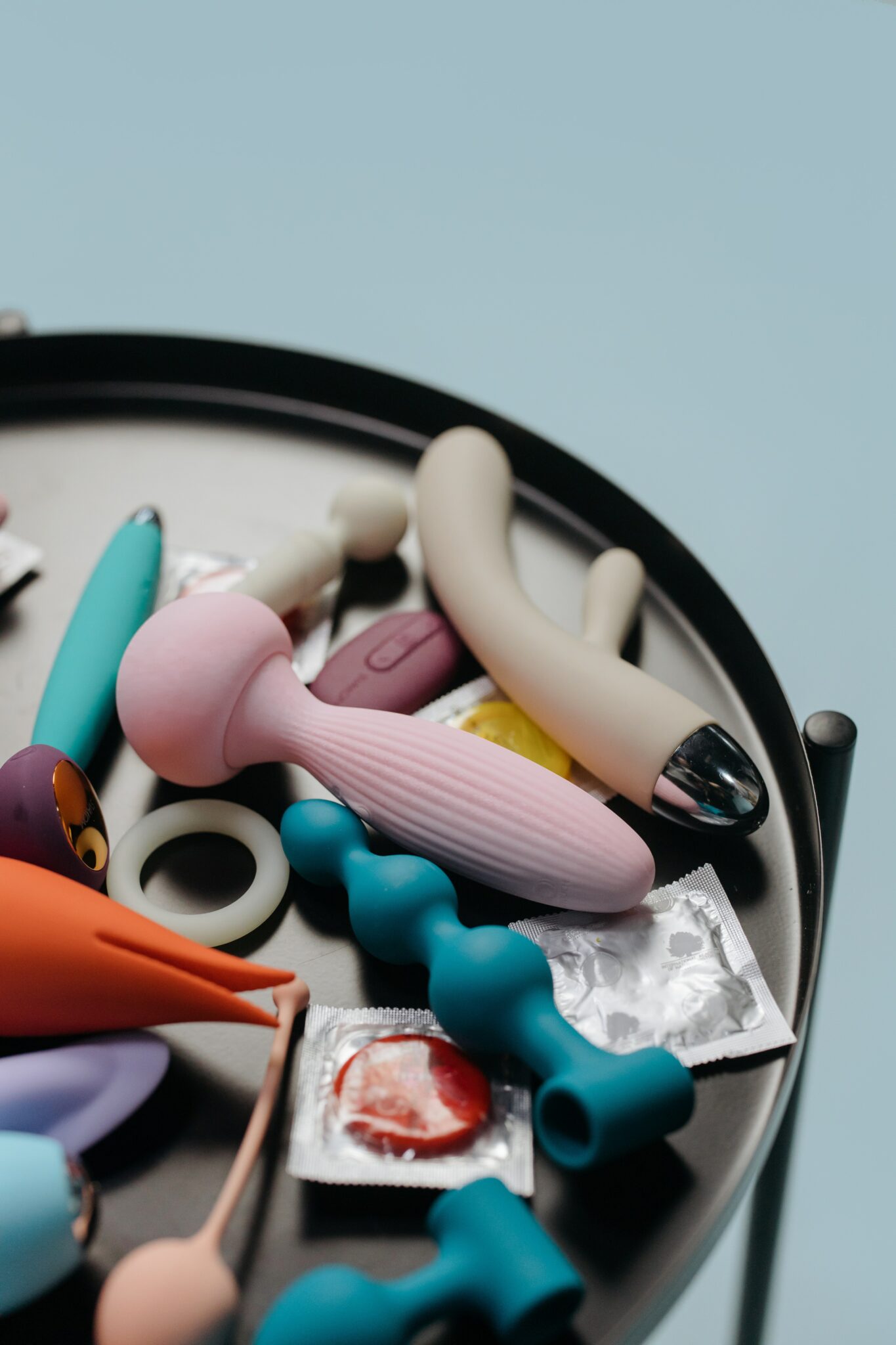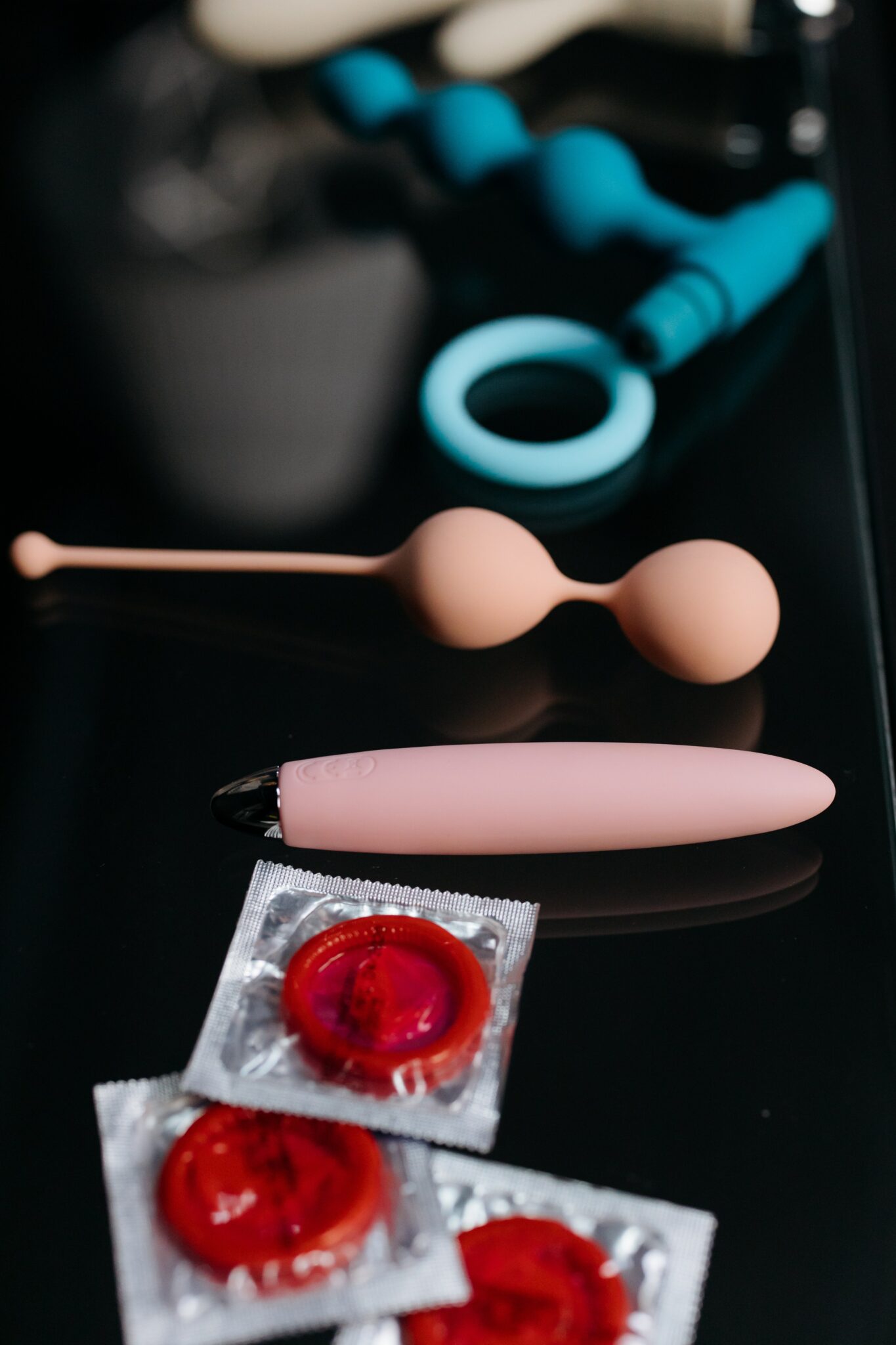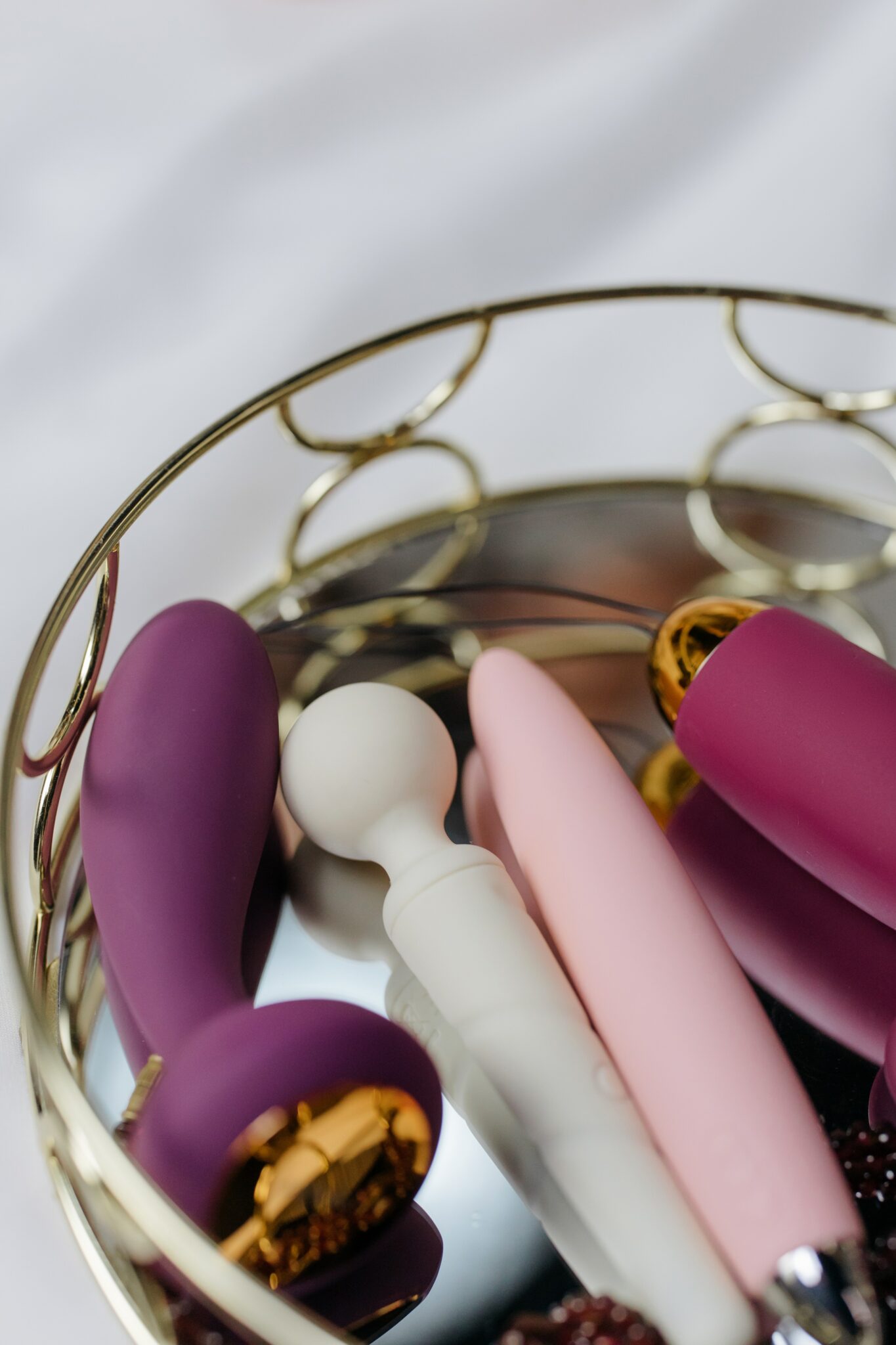Candles are lit. Bath is running. Smooth, snazzy music in the background… you’re ready to indulge in some self-love. You slide your favorite sex toy out of its velvet bag and get excited, fully assured that your favorite sex toy is made of medical-grade silicone, is 100% sanitized, bacteria- and toxin-free, and safe for your body. Wait, hold up… are we really 100% sure it’s made of body-safe sex toy materials, regardless of what it says on the label? (Personally, I’ve had a vibe or two that steered me wayyyy wrong!)
I think we can all agree that sex toys are fucking fantastic, pardon the pun. Whether you’re someone who loves their single trusty vibrator or have an ever-expanding array of toys to experiment with, the diversity of experiences that sex toys bring into the bedroom (or anywhere) is much appreciated.
But did you know, not all sex toys were created equal? High-quality sex toys and dildos are made out of medical or food-grade material and are non-porous, hypoallergenic and safe for intimate contact. However, many lower-quality sex toys are made out of toxic materials that were never meant to be used on or in our bodies — and can cause some serious side effects (more below).
This guide describes every sex toy material you should know about — the good and the bad — so you can learn what dildos are actually made of, the best toy materials to choose, and the toxic materials to avoid putting anywhere near your intimate parts.
Are All Sex Toys Safe?
Sex toy production is an unregulated industry, and there are currently no FDA regulations on the materials used. This means that manufacturers can get away with using dangerous chemicals in sex toys to reduce expenses and boost profits. Retailers can put false claims on packaging without repercussions – for instance, a toxic toy may be labeled “silicone” or “phthalates-free” to mislead the consumer when it’s actually silicone mixed with a toxic or porous material, or an entirely different substance like rubber a shady “sil-a-gel” mix. To the consumer, this might look like body-safe silicone — but upon further inspection, it isn’t actually a silicone sex toy (or safe) at all.
A high-quality sex toy will clearly state the materials (usually silicone or plastic) without any additional chemicals mixed in — and you’ll usually find the best toys from brand names with good reputations, rather than toys with an unknown brand name, no online presence, or that seem to be available wholesale at very low costs.
Lower-quality sex toys may sometimes look like higher-end toys, but you’ll often find them in cheaper stores, in clear packaging and with jiggly jelly, see-through, or even glittery materials. These sex toys are made out of toxic materials that were never meant to be used on or in our bodies — and can hurt the delicate tissues of the vagina. Using toys with low-quality materials could cause side effects like burning, rashes, blistering, carcinogen exposure, allergic reactions, and bacterial infections. These low-cost manufacturers skimp on high-end materials to mass-produce products at a lower cost, regardless of the health consequences. Capitalism at work, even in our bedrooms and our bodies!
Safe Sex Toy and Dildo Materials
When you’re looking for body-safe sex toy materials, you want to seek toys that are both non-toxic and non-porous. This means that they are free from harmful chemicals, and they won’t absorb bacteria or break down over time. Toys made from body-safe materials are meant to last for years to come! Here’s how to tell if your sex toys are body-safe.
100% Silicone Sex Toys Are Body-Safe
Widely regarded as the gold standard sex toy material — silicone is usually the top choice for high-quality sex toys. The best silicone toys are made of 100% medical-grade silicone. This type of silicone is platinum-cured, which gives it both high strength and flexibility. Food-grade silicone is also considered body-safe, however, food-grade is cured with peroxide, while medical-grade silicone is cured with platinum, making it the top body-safe choice overall.
Silicone sex toys are super smooth and can be made in different densities to provide different sensations (whether you want a harder toy, a softer life-like toy, a glossy finish, or a smooth and silky wrap to a vibrator). It is also non-porous and can withstand extreme temperatures, so some folks even test their silicone sex toys with a lighter to ensure it’s real silicone (which won’t melt or burn). Since they can take the heat, silicone dildos can be sanitized in boiling or running them through the dishwasher (as long as they don’t have any vibrating or electric components).
One of the most iconic vibrators, a classic even to our slutty ancestors, the Magic Wand Rechargable, is made with a silicone head for ultimate body-safe pleasure. The Magic Wand Mini and Plus also feature this safe and sensual material.
So, what about “silicone mixes” or “sil-a-gel”? Retailers can put a “silicone” label on the box even if the toy is made with primarily something else, as long as silicone is in it. Always look for “100% Silicone”, as some companies will use the silicone label for toys with as little as 10% of it in the ingredients. A silicone “blend” often means the toy is porous, contains other rubbers and elastomer materials, and could contain toxic additives. Even “medical grade silica gel” is still not the same as 100% medical-grade silicone.
Glass Sex Toys are Body Safe!
Glass is another body-safe, non-porous material that is overall safe for your body — and since it can also withstand high temperatures, it’s also easy to clean. There are two main types of glass material: borosilicate glass (one of the strongest types of glass) and soda-lime glass (cheaper and weaker).
Borosilicate glass is the ideal glass sex toy material – especially when it is carefully annealed. Annealing is how glass is heated and cooled — a lengthy process that requires a lot of skill, yet makes the glass very tough and stable so it’s less likely to break.
Cheaper sex toys that are manufactured with soda-lime glass are more prone to breaking. If a glass toy is not properly annealed, it will also break more easily. Some cheaper glass dildos might be coated with a glaze or varnish, which you definitely want to avoid. The glaze can contain highly toxic materials like cadmium and lead. Stick to a glass dildo you can see through!
Plastic Sex Toys
Hard plastics, like ABS plastic and medical-grade plastics, are also safe sex toy materials. Hard plastic is non-porous. However, plastic can sometimes crack over time. Always handle toys carefully, and if you notice a plastic toy is cracked, replace it. Bacteria can collect on a cracked surface over time and cause irritation or infection.
Stainless Steel Sex Toys
100% medical-grade stainless steel is used in surgical tools and piercings – it is a very safe material for sex toys. Polished metals like aluminum sex toys that are powder-coated with body-safe coloring are also safe. Metal sex toys are super smooth, warm up quickly, and provide a good weight and sensation for play!
One of the best stainless steel sex toys on the market right now is the Njoy Pure Wand. This metal G-spot sex toy is sleek, has a solid weight and is a delightful tool for temperature play. If you’re looking for anal toys, the Njoy Pure Plug is just as stunning and durable.
Wood, Ceramic, and Stone Toys
While these materials are less common, you’ll sometimes find body-safe sex toys with these unique materials, usually in small batches by independent companies. Just make sure they’re properly manufactured and coated by a reputable seller before purchasing.
Wood can be carved in unique shapes that are unachievable with other materials. When coated with an impermeable medical-grade sealant (usually epoxy or polyurethane), it is very safe. Glazed and kiln-fired ceramic is also safe and not porous, and make for smooth and beautiful sex toys. Highly polished natural stones are safe and have a good weight to them, yet some may be slightly porous and contain sealants. Ask the crafter about the materials used to make sure it’s safe.
Non-Toxic, but Not Body-Safe Materials
Some sex toy materials aren’t necessarily “toxic”, but contain small pores that absorb bacteria and can break down over time. Use these materials with caution, and consider covering toys with a condom to prevent them from harboring bacteria.
TPE or TPR are Porous, so Hold Bacteria
TPE/TPR (thermoplastic elastomer/rubber) is a very common sex toy material, especially for masturbation sleeves and cheaper cock-rings, as it is very flexible, jelly-like, and stretchy. These materials are non-toxic but porous, so if it’s a cheap cock ring that you want to dispose of after one or two uses, that might be fine — but if it’s a toy you want to use long-term like a masturbation sleeve, you’ll likely want to upgrade to a soft silicone material before all that bacteria gets stuck in its pores.
Porous materials have microscopic holes can harbor microorganisms, such as bacteria, mold, mildew, and fungus, which can cause infections. Porous sex toys can never be completely sanitized or sterilized. This means that a porous toy should never be used both vaginally and with anal play. It should also not be shared between partners as there cannot be 100% protection against the transmission of STIs, even once cleaned. The material is also chemically unstable and will break down over time.
TPE/TPR toys designed for non-internal use like masturbation sleeves and massager wand heads are fine for a few short-term uses, though you should still replace them after a few uses. Examine them closely before every use and watch out for tears, black spots, discolorations, or weird odors.
Toxic Sex Toy and Dildo Materials
There are some sex toy materials you should avoid no matter what. They often contain chemical additives and plasticizers and are known to cause irritation and reactions, or are simply harmful for your body in general.
Rubber, Jelly, and Gel Mixes are Toxic
Toxic sex toys are made from a mysterious concoction of ingredients including rubbers, melted plastics, and oils. They may say rubber on the packaging, or are also often called jelly or gel — including any material mixes with those words. Jelly toys will often be clear or sparkly, and very flexible. They’ll have a strange plastic-y or rubbery odor and can light on fire (unlike silicone). These toys are made with hard base materials that are heated up and mixed with additives and plasticizers to soften them, which are not considered body-safe or food-safe and can even be chemicals that are banned from children’s toys or food storage products (let alone medical-quality devices). No one knows for sure what’s in these toys without a lab test, but they are known to cause reactions from burning and itching, to sores and blisters. The sparkly pink rabbit might look cute on the shelf — but isn’t cute once it’s making your body physically uncomfortable or causing pain. Avoid these toys, no matter how tempting they seem!
PVC and Vinyl are Okay for External Use, Not Internal
PVC and Vinyl are also often used, and although they aren’t toxic per se, they are often softened with non-body-safe plasticizers to create sex toys. Plasticizers are volatile oils and acids that turn hard plastic into rubber, creating an unstable mixture that could melt easily. While this is usually fine for external use (such as clitoral vibrators or PVC or vinyl fetish wear) it’s not recommended to use internally as an anal toy or dildo material.
When PVC or vinyl toys are used for oral, vaginal or anal stimulation, these plasticizers leak out, causing the harmful chemicals to be absorbed into the body’s mucous membranes. A common toxic plasticizer is phthalate, which is why many toys will say they’re phthalate-free. Phthalate exposure can cause organ damage and possibly cancer. Some toys can contain up to 70% phthalates! People who use sex toys with phthalates often report experiencing symptoms such as burning sensations, rashes, blistering, headaches, nausea and cramps. Not fun.
Retailers often take advantage of consumers by using misleading material terms. For instance, “skin-safe rubber” claims that rubber is latex-free and phthalates-free, but this may not be true as it’s an unregulated industry, and some kind of unknown plasticizer still needed to be mixed with the rubber to turn it into a toy. These ingredients can be equally harmful. Ingredients to watch for include polystyrene, polyethylene, SBS (styrene-butadiene-styrene), and EPDM (ethylene propylene diene monomer), though any mix should lead to some suspicion.
Should you put a condom on your sex toys?
In general, if you’re using a body-safe sex toy, you don’t need to put a condom on it (unless you’re switching from anal to vaginal or oral, and don’t want to clean in between). You might also want to put a condom on a toy if you’re swapping between non-fluid-bonded partners, and want to reduce the risk of STIs.
Many folks use condoms with porous toys to prevent bacteria from harboring in the holes, or if there is bacteria on the toy already, prevent it from making contact with their genitals. While this is a great solution, you still may want to opt for a higher-quality toy material to avoid the fuss and enhance your pleasure.
When it comes to toxic toy materials — a condom won’t help you. The toxic oils seeping out of your dildo could cause a latex condom to disintegrate, rendering it useless. You might consider using polyurethane or nitrile condoms, though you may notice the cost of doing so adds up over time, and it’s not a guarantee that certain chemicals won’t compromise their integrity. Also, the condom will need to cover the entire toy to protect it completely, and it is unlikely a single condom can achieve this, particularly for large or unusually shaped toys. If you do go the condom route, get non-lubricated condoms and add your own water-based lube if desired. Many condoms use silicone lube, which isn’t compatible with silicone toys or silicone mixes.
The cost of polyurethane/nitrile condoms + the cost of replacing the porous toy every few months is ultimately more expensive than buying a high-quality non-porous toy from the start — so we’d recommend erring on the side of buying a high-quality toy from a reputable seller.
How can tell if it’s a high-quality sex toy?
With misleading names and labels rampant in this unregulated industry, it can be hard to confirm whether your sex toy or dildo is made from non-toxic body-safe materials. We recommend always buying your sex toys from a reputable brand and manufacturer and reading lots of reviews (like the ones on our site!) to get the real details about toy experiences. Personally, we only review high-quality, body-safe toys on Slutty Girl Problems and recommend toys from our favorite sex-positive shops that also want to put your safety first. After all, investing in a quality sex toy is a form of self-love — and you deserve to love your body right!
If you’re looking for the Slutty Girl’s complete guide to the best sex toys, we’ve compiled a list of body-safe and exciting items for you to try solo or with your partner!





